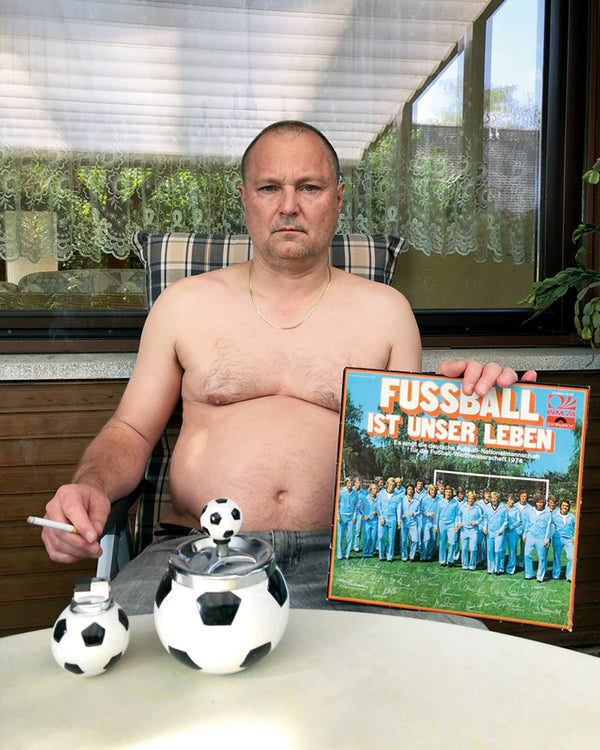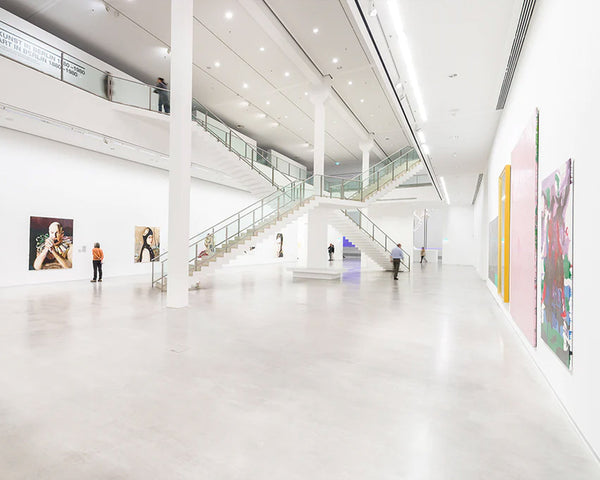ARNO BRANDLHUBER
by David Jenal
 Arno Brandlhuber is an architect, urban development visionary and passionate sauna-goer. From 2012 to 2014, he converted the St. Agnes church built by Werner Düttmann in Berlin-Kreuzberg into what it is today: König Galerie. The architect receives me in his office in Berlin Mitte, not far from Rosenthaler Platz. He is wearing a dark shirt, dark jeans and dark shoes, obviously and upscale version of the inconspicuous architect’s uniform. Telling him that I’m not an architecture critic and don’t want to discuss his urban concepts, he seems happy: „Very good.“ As much as Arno Brandlhuber is not into talking about his ideas for prospective urban living culture, the relationship between art and architecture is what arouses his attention. Brandlhuber thinks big and associatively. Whilst he speaks on the White Cube, structural unity, and the luxury goods industry, it gets difficult to follow him. At the same time, his issues are simple: Architecture is not art, and the same is true vice versa. When Brandlhuber says „Olafur Eliasson and Donald Judd are and were not architects“, he doesn’t sound bitter; it’s simply convincing. The architect has no objection to the dissolution ofexisting boundaries. On the contrary, the fact that you can also buy Riva yachts at Gagosian, or that auction houses carry old-timers alongside art, and „Johann is about to publish a magazine”, is ”completely understandable” to him.
Arno Brandlhuber is an architect, urban development visionary and passionate sauna-goer. From 2012 to 2014, he converted the St. Agnes church built by Werner Düttmann in Berlin-Kreuzberg into what it is today: König Galerie. The architect receives me in his office in Berlin Mitte, not far from Rosenthaler Platz. He is wearing a dark shirt, dark jeans and dark shoes, obviously and upscale version of the inconspicuous architect’s uniform. Telling him that I’m not an architecture critic and don’t want to discuss his urban concepts, he seems happy: „Very good.“ As much as Arno Brandlhuber is not into talking about his ideas for prospective urban living culture, the relationship between art and architecture is what arouses his attention. Brandlhuber thinks big and associatively. Whilst he speaks on the White Cube, structural unity, and the luxury goods industry, it gets difficult to follow him. At the same time, his issues are simple: Architecture is not art, and the same is true vice versa. When Brandlhuber says „Olafur Eliasson and Donald Judd are and were not architects“, he doesn’t sound bitter; it’s simply convincing. The architect has no objection to the dissolution ofexisting boundaries. On the contrary, the fact that you can also buy Riva yachts at Gagosian, or that auction houses carry old-timers alongside art, and „Johann is about to publish a magazine”, is ”completely understandable” to him.Brandlhuber definitely wants to talk about Johann, the St. Agnes Church and KÖNIG GALERIE. He’s brought copies of a book. “There’s a book about Düttmann and St. Agnes. When we rebuilt the church, we just deleted a few sentences and pages from the book, and there was our project text.” Brandlhuber’s intervention into St. Agnes was minimal: he built a ceiling to split the church nave into two floors. He compares this gesture to drawing a single line; a gesture as delicate as it is grandiose. “The church is still the same. Visitors should think: this is a Düttmann.”
Brandlhuber makes no secret of his admiration for Düttmann: „He was a cool cat.“ Alongside the Akademie der Künste, he calls St. Agnes the architect’s best building, because the church is so „brutalist, brutiful“. When, towards the end of construction works, the money ran out, Düttmann himself painted the pieces that were hung in St. Agnes during its use as a church. Brandlhuber sees this as a „cool gesture.“
The 53-year-old‘s choice of words: cool, wicked, brutiful, sound like those of a pubescent Internet age fanboy, and perhaps Brandlhuber is just that: an enthusiastic, wild and well-informed boy. He speaks fast, sometimes a bit flippant, but often reflective and pointed. During our conversation, rather than sit on the sofa as I do, he sits on a concrete edge. Hard material is clearly his natural habitat.
He’s known for working with exposed concrete more than he is with churches. Still, he’s no stranger to them. Brandlhuber was an alter boy in a Catholic church in Detting am Main. That church, built by Dominkus Böhm, was one of the first expressionist churches in Germany. “That church is a big part of and has a lot to do with my having become an architect.”
Enough of the church rapture. Swift change of topics: Brandlhuber visits his sauna much more frequently than he does houses of worship. On the roof of the Brunnenstraße building, where he both works and lives, there’s a small, cube shaped and fully glazed sauna. „You have the best view into the night sky from there.“ Before the private sauna on the roof, the Herkules baths in cologne has been Brandlhuber’s favorite sauna. “Towards the evening, Turkish boxers would come in and order endless Kölsch and food to the sauna from an old telephone hanging on the wall. That was great.” For the bath master’s birthday, they also ordered a Turkish belly dancer to the sauna area. According to Brandlhuber everything was “totally sexualized.”
Arno Brandlhuber is really into those jingo stories. Sweat, beer, women, a lot of skin and few inhibitions. The architect is clearly what you call a macho. His well known Antivilla on Krampnitzsee near Potsdam, for which Brandlhuber converted an old sewing shop, is, at least visually, a thourougly virile building: roughly crafted windows set into the thick walls, exposed concrete, and spacious rooms. “The house promises hedonism, joy, freedom and luxury at a small cost” – all the things you’d immediately associate with Brandlhuber’s personality.
But to compare Brandlhuber with his most spectacular building so far is destined to fail. The Antivilla is located on the countryside. “Living in the country consumes a lot of land, and you have to heat in all six directions. On an energy and infrastructure level it’s total nonsense. Houses in the countryside should be demolished.”



